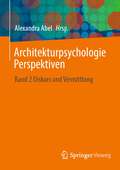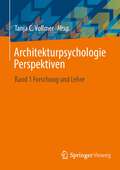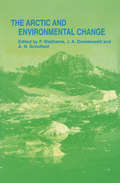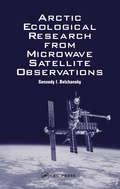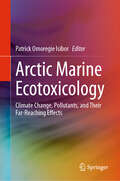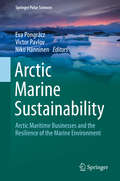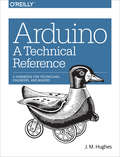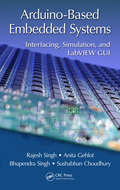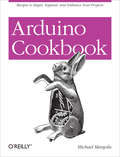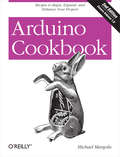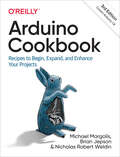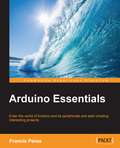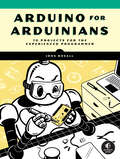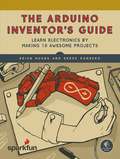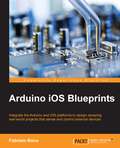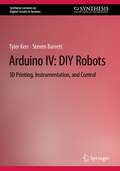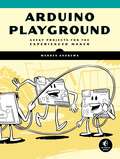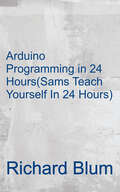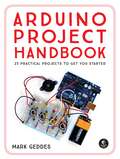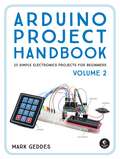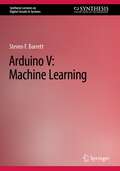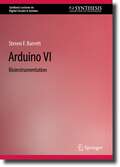- Table View
- List View
Architekturpsychologie Perspektiven: Band 2 Diskurs und Vermittlung
by Alexandra AbelIn der gebauten und vom Menschen beeinflussten Umwelt manifestiert sich unser Leben: Lebenshaltung, Lebensformen, Lebensentwurf. Indem man Architektur neu denkt, hat man daher das Potential, die derzeitige Form unseres Lebens zu überdenken. Ein solches Neu, Anders braucht eine Sensibilisierung für die Relevanz der gebauten Umwelt, für die Werte und Zielgrößen, die hinter einer bestimmten Gestaltung stehen und braucht einen gesamtgesellschaftlichen Diskurs zu der zentralen Frage: Wie wollen wir leben? Wie dürfen wir leben? Vor dem Hintergrund ökologischer und ökonomischer Fairness: Welche Lebensformen sind kompatibel mit einer möglichst hohen Lebensqualität für uns alle, als Teil eines Ökosystems, mit dem unser Wohlbefinden unauflöslich verbunden ist. In diesem Band kommen namhafte Expertinnen aus Österreich, der Schweiz und Deutschland aus den Disziplinen der Architektur, der Psychologie, der Kunst und Kunstdidaktik zu Wort, die sich zu der Relevanz und zu den Voraussetzungen einer solchen Debatte äußern.
Architekturpsychologie Perspektiven: Band 3 Entwurf und Prozess
by Martina GuhlWie findet die Begegnung von Psychologie und Architektur während des Entwurfs- und Planungsprozesses statt? In welchem Planungsabschnitt wird architekturpsychologisches Wissen relevant und einsetzbar? Welche Erkenntnisse liefert die urbane Architekturpsychologie für den städtebaulichen Diskurs? In diesem Buch bringen renommierte Expert*innen aus Deutschland, der Niederlande und der Schweiz aus den Disziplinen Architektur, Psychologie, Städtebau, Farbgestaltung und Kommunikationspsychologie ihr Pionierwissen ein.
Architekturpsychologie Perspektiven: Band 1 Forschung und Lehre
by Tanja C. VollmerWas können wir aus der Forschung über die Wirkung von Architektur auf Gesundheit und Erleben der Menschen lernen? Wie vermitteln wir die interdisziplinären Erkenntnisse heute und morgen? In diesem Buch wird die Architekturpsychologie als Schlüsselkonzept der gesundheitsbezogenen Evidence Based Design Forschung vorgestellt. Dabei entwickeln renommierte Wissenschaftler:innen aus Deutschland, Dänemark und der Schweiz anhand verständlicher Beispiele ihre Forschungs- und Lehrperspektiven u.a. zum Krankenhaus-, Schul- und Städtebau sowie zum Design. Unterschiede der phänomenologischen, explorativen und empirischen Forschung werden herausgearbeitet sowie hilfreiche Modelle und Konzepte der modernen Architekturpsychologie erklärt. Einleitend wirft der Band einen Blick auf Entstehung und aktuellen Stand der Architekturpsychologie in Deutschland.
Archiving Strategies for Evolutionary Multi-objective Optimization Algorithms (Studies in Computational Intelligence #938)
by Oliver Schütze Carlos HernándezThis book presents an overview of archiving strategies developed over the last years by the authors that deal with suitable approximations of the sets of optimal and nearly optimal solutions of multi-objective optimization problems by means of stochastic search algorithms. All presented archivers are analyzed with respect to the approximation qualities of the limit archives that they generate and the upper bounds of the archive sizes. The convergence analysis will be done using a very broad framework that involves all existing stochastic search algorithms and that will only use minimal assumptions on the process to generate new candidate solutions. All of the presented archivers can effortlessly be coupled with any set-based multi-objective search algorithm such as multi-objective evolutionary algorithms, and the resulting hybrid method takes over the convergence properties of the chosen archiver. This book hence targets at all algorithm designers and practitioners in the field of multi-objective optimization.
Arctic and Environmental Change
by J. A. DowdeswellThis timely book presents a wide-ranging review of Arctic environmental change in response to global warming, and gives a broad insight into the transformation of the Arctic which we can expect during the next century. It is in high northern latitudes that we can expect to observe global warming at its most powerful, making it a natural laboratory where climate changes and their impacts can be monitored and studied more readily than elsewhere in the world. Fourteen authoritative reviews cover the predictions of warming rates by General Circulation Models; variabilities in atmospheric circulation and moisture flux; the dynamics of the polar vortex in the Arctic and its role in ozone loss; the countervailing influence of air pollution in reducing solar irradiance; and the impact of climatic change on Arctic terrestrial and marine ecosystems. Also detailed are the thermohaline circulation of the ocean, the extent and thickness of sea ice, the sizes of glaciers and ice sheets, and the extent of permafrost. Moving to past changes, the records from Greenland ice cores and deep ocean drilling are reviewed for what they tell us about past climates and glaciation in the Arctic., The book paints a vivid and disturbing picture of the enhanced warming that can be expected in the Arctic relative to lower latitudes, and of the major impacts that this will have on the northern cryosphere. It will be an invaluable reference for anyone seeking a greater understanding of the factors and processes affecting the arctic environment, which may ultimately have a major impact on global climatic change.
Arctic Ecological Research from Microwave Satellite Observations
by Gennady I. BelchanskyActive (imaging radar) and passive (radiometer) microwave systems are increasingly used for Arctic ecological research. Unfortunately, until now ecologists interested in remote sensing often lacked access to the full suite of physical and analytical techniques of microwave systems, data processing, and ecological applications because a suitable ref
Arctic Marine Ecotoxicology: Climate Change, Pollutants, and Their Far-Reaching Effects
by Patrick Omoregie IsiborThis book explores the fragile Arctic marine environment from the perspective of marine toxicology, shedding light on the intricate relationship between pollution, contaminants, and Arctic ecosystems. It examines the challenges of preserving this delicate habitat and the need to conserve the inherent lifeforms found there. The book introduces the unique characteristics of Arctic marine life. It delineates climate change and the effects of pollutants, analyzing their far-reaching impacts on the complex waters of Arctic marine toxicology. It also examines the regulatory frameworks required to safeguard these vulnerable ecosystems and presents case studies and ethical considerations. Fundamentals of Arctic Marine Toxicology: Climate Change, Pollutants, and Their Far-Reaching Effects is a valuable resource for researchers, policymakers, industry professionals, and environmental stewards. Its interdisciplinary approach encompasses climate change, conservation, biology, environmental science, and toxicology. It offers a holistic understanding of the Arctic's ecological intricacies and the challenges posed by anthropogenic disturbances caused by human activities motivated by economic gain. The book serves as a guide towards a future of eco-friendly innovations that align with environmental stewardship. It envisions a world of sustainable Arctic marine ecosystems achieved through responsible and sustainable practices.
Arctic Marine Sustainability: Arctic Maritime Businesses and the Resilience of the Marine Environment (Springer Polar Sciences)
by Eva Pongrácz Victor Pavlov Niko HänninenThis book presents the latest scientific views on resource use conflicts in the Arctic seas. The main areas of focus are the biological resources of Arctic seas vs. exploitation of oil and gas resources, and the conflicts in between. In addition, climate change is presented as a stressor, which both limits and facilitates the economic availability of resources in the Arctic. The book is divided into five parts. Part 1 examines Arctic ecosystems, resilience of the marine environment and possible conflicts between industrial sector and biological world. The focus of Part 2 is on transport infrastructure along the northern routes. Issues such as Arctic maritime operations, black carbon and unmanned aerial vehicles are considered. Part 3 focuses on resource use conflicts in Arctic seas and on the most recent threats in terms of Arctic oil and gas exploration, offshore logistics operations as well as transportation of oil and oil products. Discussions in Part 4 of the book are concentrated around social aspects and involvement of local communities. Tourism development, preservation of indigenous culture, engagement of communities on relevant Arctic issues, search and rescue in the cold marine environment are examples of questions raised. The book reviews Arctic-specific petroleum regulations, the state of preparedness to oil spill accidents in the region as well as the latest developments in oil spill response technologies and their limitations. Search and rescue operations are reviewed and how working in this harsh Arctic environment affects the ability of rescue technicians to perform the required technical skills. Part 5 considers the sustainability challenges arising from the marine resource exploitation. The focus is on the vulnerability of Arctic ecosystems to disturbance – both natural and anthropogenic.
Arde la luz: Guía para entender el precio de la electricidad
by Ignacio Gistau CosculluelaUna explicación clara y concisa del mercado eléctrico, un debate de rabiosa actualidad. En las noticias, en las primeras páginas de los periódicos, en acaloradas conversaciones con amigos. Unánime en la indignación, la sociedad tiene tantas soluciones como personas la conforman. Pero ¿cuál es la realidad del mercado eléctrico? ¿Cómo se forman los precios? Y sobre todo: ¿son excesivos? Ignacio Gistau ha dedicado toda su carrera profesional a los mercados de la energía de España, Alemania y Reino Unido. Tras más de veinte años conociendo en primera persona la evolución de los mercados eléctricos globales, ofrece claves sencillas y comprensibles para entender el actual precio de la electricidad.
Arduino: A Handbook for Technicians, Engineers, and Makers
by J. M. HughesRather than yet another project-based workbook, Arduino: A Technical Reference is a reference and handbook that thoroughly describes the electrical and performance aspects of an Arduino board and its software.This book brings together in one place all the information you need to get something done with Arduino. It will save you from endless web searches and digging through translations of datasheets or notes in project-based texts to find the information that corresponds to your own particular setup and question.Reference features include pinout diagrams, a discussion of the AVR microcontrollers used with Arduino boards, a look under the hood at the firmware and run-time libraries that make the Arduino unique, and extensive coverage of the various shields and add-on sensors that can be used with an Arduino. One chapter is devoted to creating a new shield from scratch.The book wraps up with detailed descriptions of three different projects: a programmable signal generator, a "smart" thermostat, and a programmable launch sequencer for model rockets. Each project highlights one or more topics that can be applied to other applications.
Arduino-Based Embedded Systems: Interfacing, Simulation, and LabVIEW GUI
by Rajesh Singh Anita Gehlot Bhupendra Singh Sushabhan ChoudhuryArduino is an open-source electronics platform based on easy-to-use hardware and software while LabVIEW is a graphical programming telling how to connect functions and work with a variety of datatypes when constructing applications.This book will help beginners to get started with Arduino-based embedded systems including essential know-how of the programming and interfacing of the devices. Book includes programming and simulation of Arduino-based projects and interfacing with LabVIEW, based on practical case studies. The book comprises of total twenty five chapters with description, working model of LabVIEW and programming with Arduino IDE.
Arduino Cookbook (Oreilly And Associate Ser.)
by Michael MargolisCreate your own toys, remote controllers, alarms, detectors, robots, and many other projects with the Arduino device. This simple microcontroller board lets artists and designers build a variety of amazing objects and prototypes that interact with the physical world. With this cookbook you can dive right in and experiment with more than a hundred tips and techniques, no matter what your skill level is.The recipes in this book provide solutions for most common problems and questions Arduino users have, including everything from programming fundamentals to working with sensors, motors, lights, and sound, or communicating over wired and wireless networks. You'll find the examples and advice you need to begin, expand, and enhance your projects right away.Get to know the Arduino development environmentUnderstand the core elements of the Arduino programming languageUse common output devices for light, motion, and soundInteract with almost any device that has a remote controlLearn techniques for handling time delays and time measurementUse simple ways to transfer digital information from sensors to the Arduino deviceCreate complex projects that incorporate shields and external modulesUse and modify existing Arduino libraries, and learn how to create your own
Arduino Cookbook: Recipes to Begin, Expand, and Enhance Your Projects (Oreilly And Associate Ser.)
by Michael MargolisWant to create devices that interact with the physical world? This cookbook is perfect for anyone who wants to experiment with the popular Arduino microcontroller and programming environment. You'll find more than 200 tips and techniques for building a variety of objects and prototypes such as toys, detectors, robots, and interactive clothing that can sense and respond to touch, sound, position, heat, and light. You don't need experience with Arduino or programming to get started. Updated for the Arduino 1.0 release, the recipes in this second edition include practical examples and guidance to help you begin, expand, and enhance your projects right away--whether you're an artist, designer, hobbyist, student, or engineer. Get up to speed on the Arduino board and essential software concepts quickly Learn basic techniques for reading digital and analog signals Use Arduino with a variety of popular input devices and sensors Drive visual displays, generate sound, and control several types of motors Interact with devices that use remote controls, including TVs and appliances Learn techniques for handling time delays and time measurement Apply advanced coding and memory handling techniques
Arduino Cookbook: Recipes to Begin, Expand, and Enhance Your Projects (Oreilly And Associate Ser.)
by Michael Margolis Brian Jepson Nicholas Robert WeldinWant to create devices that interact with the physical world? This cookbook is perfect for anyone who wants to experiment with the popular Arduino microcontroller and programming environment. You’ll find more than 200 tips and techniques for building a variety of objects and prototypes such as IoT solutions, environmental monitors, location and position-aware systems, and products that can respond to touch, sound, heat, and light.Updated for the Arduino 1.8 release, the recipes in this third edition include practical examples and guidance to help you begin, expand, and enhance your projects right away—whether you’re an engineer, designer, artist, student, or hobbyist.Get up to speed on the Arduino board and essential software concepts quicklyLearn basic techniques for reading digital and analog signalsUse Arduino with a variety of popular input devices and sensorsDrive visual displays, generate sound, and control several types of motorsConnect Arduino to wired and wireless networksLearn techniques for handling time delays and time measurementApply advanced coding and memory-handling techniques
Arduino Essentials
by Francis PereaIf you are a hobbyist who wants to develop projects based on Arduino as the main microcontroller platform or an engineer interested in finding out what the Arduino platform offers, then this book is ideal for you. Some prior knowledge of the C programming language is required.
Arduino for Arduinians: 70 Projects for the Experienced Programmer
by John BoxallGuided by an expert craftsman with over 30 years of experience, you&’ll build 70 awesome Arduino projects and emerge a true Arduinian ready to invent your own complex creations.For Arduino programmers who&’ve mastered the basics, this book is the next step toward becoming an expert Arduinian. You&’ll build 70 complex and practical projects with this versatile microcontroller platform and gain advanced skills to design reliable, professional, user-friendly creations.You&’ll remote-control your Arduino via Bluetooth and instant messaging, improve the accuracy of clock projects with internet time servers, and automatically turn your Arduino off when it completes a task. You&’ll safely control AC mains power and higher currents and conserve battery with low-power and sleep modes. You&’ll also use Charlieplexing to control LED matrix displays, keep your Arduino running with a watchdog timer, communicate over longer wired distances with the RS232 and RS485 buses, and much more.Along the way, you&’ll build fun and useful devices like:• A camera-enabled circuit to stream videos• An MP3 player to listen to audio of your choice• A CAN bus circuit to gather speed and engine data from your car• A web server to display data captured with an ESP32 board• A PS/2 keyboard to improve your user interfaces and easily enter and display dataGuided by an Arduino master, you&’ll harness dozens of sensors, motors, displays, and techniques to bring your own expert inventions to life.Requirements: Arduino Uno and other Arduino-compatible microcontrollers andUSBasp programmers. Some projects may require other inexpensive parts.
The Arduino Inventor's Guide: Learn Electronics by Making 10 Awesome Projects
by Brian Huang Derek RunbergWith Arduino, you can build any hardware project you can imagine. This open-source platform is designed to help total beginners explore electronics, and with its easy-to-learn programming language, you can collect data about the world around you to make something truly interactive.The Arduino Inventor's Guide opens with an electronics primer filled with essential background knowledge for your DIY journey. From there, you’ll learn your way around the Arduino through a classic hardware entry point—blinking LEDs. Over the course of the book, 11 hands-on projects will teach you how to:–Build a stop light with LEDs–Display the volume in a room on a warning dial–Design and build a desktop fan–Create a robot that draws with a motor and pens–Create a servo-controlled balance beam–Build your own playable mini piano–Make a drag race timer to race toy cars against your friendsEach project focuses on a new set of skills, including breadboarding circuits; reading digital and analog inputs; reading magnetic, temperature, and other sensors; controlling servos and motors; and talking to your computer and the Web with an Arduino. At the end of every project, you’ll also find tips on how to use it and how to mod it with additional hardware or code.What are you waiting for? Start making, and learn the skills you need to own your technology!Uses the Arduino Uno board or SparkFun RedBoard
Arduino iOS Blueprints
by Fabrizio BocoIntegrate the Arduino and iOS platforms to design amazing real-world projects to sense and control external devices About This Book * Cover the most widely used methods in the Internet of Things using Arduino and iOS integration through Wi-Fi Shield and the BLE Breakout board * Design five real-world projects including of electronics, Arduino code, and an iOS application that seamlessly work together * A detailed guide that covers various sensors and actuators through which Arduino interacts with the world including a light sensor, hall effect sensor, accelerometer, servo motor, DC motor, and TRIAC for power line loads Who This Book Is For This book is a technical guide for Arduino and iOS developers who have a basic knowledge of the two platforms but want to learn how to integrate them. The book includes a lot of external references to additional documentation and learning materials, so even if you are less experienced, you can improve your knowledge on the subjects covered. What You Will Learn * Design circuits with Arduino using sensors and actuators * Write code to handle analog and digital sensors with the most used protocols including OneWire, I2C, and SPI) * Store data on SD Card and in EEPROM * Build iOS applications using the MCV pattern and the UIKit components * Allow your applications to control Arduino and its hooked-up devices * Manage TCP/IP, UDP, and Bluetooth BLE communication between Arduino and iOS devices * Make your iOS application take advantage of the sensors available in the iOS devices including accelerometer, gyroscope, and compass * Develop iOS applications that use iBeacons In Detail Arduino and iOS devices have reached wide popularity due to their simple way of use and flexibility. Hence, their integration opens up new opportunities, allowing everyone to build devices that are extremely useful in everyday life. You will first learn how to control Arduino from an iPhone or iPad by writing the Arduino sketch, the iOS application, and integrating everything together via Wi-Fi or Bluetooth BLE. You will then learn about various components that interact with the Arduino such as digital and analog I/O, Wi-Fi shield, Bluetooth BLE, SD card, OneWire, I2C, and so on. You will also learn about iOS, which includes the development of an application from scratch, GUI design and MVC, UIKit, iOS sensors, TCP and Bluetooth BLE communication, and more. All the projects are described in detail, providing you with a learning tool, not just some sketches or some iOS code to copy. Style and approach This is a project-based book with a step-by-step guide that covers everything that you need to build an Arduino-iOS project, right from defining the basic requirements to the coding and testing the entire project. Each chapter ends with ideas on how to improve the project and to constantly learn the topics covered.
Arduino IV: 3D Printing, Instrumentation, and Control (Synthesis Lectures on Digital Circuits & Systems)
by Tyler Kerr Steven BarrettThis book gives a step-by-step introduction to designing and building your own robots. As with other books in the Arduino series, the book begins with a quick overview of the Arduino Integrated Development Environment (IDE) used to write sketches, and the hardware systems aboard the Arduino UNO R3 and the Mega 2560 Rev 3. The level of the text makes it accessible for students, hobbyist and professionals' first introduction to both Arduino and Robotics. This book will be accessible by all levels of students, advanced hobbyists and engineering professionals, whether using as a self-reference or within a structure design laboratory. The text then examines the many concepts and characteristics common to all robots. In addition, throughout the book , reasonably priced, easily accessible and available off-the-shelf robots are examined. Examples include wheeled robots, tracked robots and also a robotic arm. After a thorough and easy to follow Arduino IDE and hardware introduction, the book launches into “do it yourself” or DIY concepts. A unique feature of the book is to start with a hands-on introduction to low cost 3D printing. These concepts will allow you to design and print your own custom robot parts and chassis. We then explore concepts to sense a robot's environment, move the robot about and provide a portable power source. We conclude with a several DIY robot projects.
Arduino Playground: Geeky Projects for the Experienced Maker
by Warren AndrewsYou’ve mastered the basics, conquered the soldering iron, and programmed a robot or two; now you’ve got a set of skills and tools to take your Arduino exploits further. But what do you do once you’ve exhausted your to-build list?Arduino Playground will show you how to keep your hardware hands busy with a variety of intermediate builds, both practical and just-for-fun. Advance your engineering and electronics know-how as you work your way through these 10 complex projects:–A reaction-time game that leverages the Arduino’s real-time capabilities–A tool for etching your own printed circuit boards–A regulated, variable-voltage power supply–A kinetic wristwatch winder decked out with LEDs–A garage parking assistant that blinks when your vehicle is perfectly parked–A practical and colorful pH meter–A ballistic chronograph that can measure the muzzle velocity of BB, Airsoft, and pellet guns–A battery saver that prevents accidental discharge–A square-wave generator–A thermometer that tells the temperature using a sequence of colored LEDsEach project begins with a list of required tools and components, followed by the instructions, full sketch, and circuit board templates for the build, as well as directions for building a permanent enclosure. You’ll even find the author’s design notes, which are sure to provide inspiration for your own inventions.Gather your parts, break out the soldering iron, and get ready to take your Arduino skills to the next level with Arduino Playground.Uses the Arduino Nano and Pro Mini boards.
Arduino Programming In 24 Hours, Sams Teach Yourself
by Richard BlumIn just 24 sessions of one hour or less, Sams Teach Yourself Arduino Programming in 24 Hours teaches you C programmingon Arduino, so you can start creating inspired “DIY” hardwareprojects of your own! Using this book’s straightforward, step-by-stepapproach, you’ll walk through everything from setting up yourprogramming environment to mastering C syntax and features, interfacing your Arduino to performing full-fledged prototyping.Every hands-on lesson and example builds on what you’ve alreadylearned, giving you a rock-solid foundation for real-world success!
Arduino Project Handbook: 25 Practical Projects to Get You Started
by Mark GeddesArduino Project Handbook is a beginner-friendly collection of electronics projects using the low-cost Arduino board. With just a handful of components, an Arduino, and a computer, you’ll learn to build and program everything from light shows to arcade games to an ultrasonic security system.First you’ll get set up with an introduction to the Arduino and valuable advice on tools and components. Then you can work through the book in order or just jump to projects that catch your eye. Each project includes simple instructions, colorful photos and circuit diagrams, and all necessary code.Arduino Project Handbook is a fast and fun way to get started with microcontrollers that’s perfect for beginners, hobbyists, parents, and educators.Uses the Arduino Uno board.
Arduino Project Handbook, Volume 2: 25 Simple Electronics Projects for Beginners
by Mark GeddesThis second volume of the Arduino Project Handbook delivers 25 more beginner-friendly electronics projects. Get up and running with a crash course on the Arduino, and then pick any project that sparks your interest and start making! Each project includes cost and time estimates, simple instructions, colorful photos and circuit diagrams, a troubleshooting section, and the complete code to bring your build to life. With just the Arduino board and a handful of components, you’ll make gadgets like a rainbow light display, noise-level meter, digital piano, GPS speedometer, and fingerprint scanner. This collection of projects is a fast and fun way to get started with microcontrollers that’s perfect for beginners, hobbyists, parents, and educators.25 Step-by-Step ProjectsLED Light BarLight-Activated Night-LightSeven-Segment LED Countdown TimerLED Scrolling MarqueeMood LightRainbow Strip LightNeoPixel CompassArduino PianoAudio LED VisualizerOld-School Analog DialStepper MotorTemperature-Controlled FanUltrasonic Range FinderDigital ThermometerBomb Decoder GameSerial LCD ScreenUltrasonic People CounterNokia 5110 LCD Screen Pong GameOLED BreathalyzerUltrasonic SoakerFingerprint ScannerUltrasonic RobotInternet-Controlled LEDVoice-Controlled LEDGPS SpeedometerUses the Arduino Uno board Praise for the first volume of Arduino Project Handbook:"Easily the best beginner’s guide out there. Pair with an inexpensive clone-based starter kit, and it’s never been cheaper to join the maker revolution."—MakeUseOf.com"Beautifully designed."—Boing Boing
Arduino V: Machine Learning (Synthesis Lectures on Digital Circuits & Systems)
by Steven F. BarrettThis book is about the Arduino microcontroller and the Arduino concept. The visionary Arduino represented a new innovation in microcontroller hardware in 2005, the concept of open source hardware, making a broad range of computing accessible for all.This book, “Arduino V: AI and Machine Learning,” is an accessible primer on Artificial Intelligence and Machine Learning for those without a deep AI and ML background. The author concentrates on Artificial Intelligence (AI) and Machine Learning (ML) applications for microcontroller–based systems. The intent is to introduce the concepts and allow readers to practice on low cost, accessible Arduino hardware and software. Readers should find this book a starting point, an introduction, to this fascinating field. A number of references are provided for further exploration.
Arduino VI: Bioinstrumentation (Synthesis Lectures on Digital Circuits & Systems)
by Steven F. BarrettThis book is about the Arduino microcontroller and the Arduino concept. The visionary Arduino team represented a new innovation in microcontroller hardware in 2005, the concept of open source hardware, making a broad range of computing accessible for all. This book, “Arduino VI: Bioinstrumentation,” is an accessible primer on bioinstrumentation for those without a deep instrumentation background. An understanding of basic circuit theory is an appropriate prerequisite for the book. The three main goals for the book are: explore accessible Arduino microcontroller programming and interfacing concepts; investigate the source and measurement of biomedical signals; and develop skills to design and implement biomedical instrumentation.
